Multispectral UAV-Based Disease Identification Using Vegetation Indices for Maize Hybrids
Abstract
1. Introduction
2. Materials and Methods
2.1. Experimental Area
- Non-infected (healthy control);
- Low dose, 5000 spore/mL;
- Medium dose, 7500 spore/mL;
- High dose, 10,000 spore/mL.
2.2. UAV Specifications and Data Collection, Analyzing Methods
- 23 June 2022 (20 days after inoculation) DAI;
- 30 June 2022 (27 day after inoculation) DAI.
- Red (R), 650 nm ± 16 nm;
- Green (G), 560 nm ± 16 nm;
- Blue (B), 450 nm ± 16 nm;
- Red Edge (RE), 730 nm ± 16 nm;
- Near-Infrared (NIR), 840 nm ± 26 nm;
- Visible Light (RGB).
| Abbrev. | Formula | References |
|---|---|---|
| NDVI | (RNIR − RRed)/(RNIR + RRed) | [28] |
| ENDVI | (RNIR + RGreen − 2 × RBlue)/(RNIR + RGreen + 2 × RBlue) | [29] |
| GNDVI | (RNIR − RGreen)/(RNIR + RGreen) | [30] |
| NDRE | (RNIR − RRedEdge)/(RNIR + RRedEdge) | [31] |
| LCI | (RNIR − RRedEdge)/(RNIR + RRed) | [32] |
3. Results
- CS 0 (healthy untreated plots in three replications);
- CS 5000 (low dose, 5000 s/mL infection in three replications);
- CS 7500 (medium dose, 7500 s/mL infection in three replications);
- CS 10,000 (high dose, 10,000 s/mL infection in three replications).
- T 0 (Healthy untreated plots in three replications);
- T 5000 (low dose, 5000 s/mL infection in three replications);
- T 7500 (medium dose, 7500 s/mL infection in three replications);
- T 10,000 (high dose, 10,000 s/mL infection in three replications).
3.1. Data Distribution and Correlations in Dessert R78 Hybrid
3.2. Variance Analyses of the VI Values of the Dessert R78
3.3. Data Distribution of Forage Maize P9025 Hybrid (T Hybrid)
3.4. Comparison of Values of Hybrids Dessert R78 and P9025
4. Discussion
5. Conclusions
Author Contributions
Funding
Institutional Review Board Statement
Data Availability Statement
Conflicts of Interest
References
- Delgado, J.A.; Short, N.M., Jr.; Roberts, D.P.; Vandenberg, B. Big data analysis for sustainable agriculture on a geospatial cloud framework. Front. Sustain. Food Syst. 2019, 3, 54. [Google Scholar] [CrossRef]
- Berry, J.K.; Delgado, J.A.; Khosla, R.; Pierce, F.J. Precision conservation for environ-mental sustainability. J. Soil Water Conserv. 2003, 58, 332–339. [Google Scholar]
- Aubert, B.A.; Schroeder, A.; Grimaudo, J. IT as enabler of sustainable farming: An empirical analysis of farmers’ adoption decision of precision agriculture technology. Decis. Support Syst. 2012, 54, 510–520. [Google Scholar] [CrossRef]
- Pierpaolia, E.; Carlia, G.; Pignattia, E.; Canavaria, M. Drivers of precision ag-riculture technologies adoption: A literature review. Proc. Technol. 2013, 8, 61–69. [Google Scholar] [CrossRef]
- Gebbers, R.; Adamchuk, V. Precision agriculture and food security. Science 2010, 327, 828–831. [Google Scholar] [CrossRef] [PubMed]
- Zhang, N.; Wang, M.; Wang, N. Precision agriculture—A worldwide overview. Comput. Electron. Agric. 2002, 36, 113–132. [Google Scholar] [CrossRef]
- Bongiovanni, R.; Lowenberg-DeBoer, J. Precision agriculture and sustainability. Precis. Agric. 2004, 5, 359–387. [Google Scholar] [CrossRef]
- Sishodia, R.P.; Ray, R.L.; Singh, S.K. Applications of remote sensing in preci-sion agriculture: A review. Remote Sens. 2020, 12, 3136. [Google Scholar] [CrossRef]
- Whitehead, K.; Hugenholtz, C.H.; Myshak, S.; Brown, O.; LeClair, A.; Tamminga, A.; Barchyn, T.E.; Moorman, B.; Eaton, B. Remote sensing of the environment with small unmanned aircraft systems (UASs), part 2: Scientific and commercial applications. Drone Syst. Appl. 2014, 2, 86–102. [Google Scholar] [CrossRef]
- Chang, C.Y.; Zhou, R.; Kira, O.; Marri, S.; Skovira, J.; Gu, L.; Sun, Y. An Unmanned Aerial System (UAS) for concurrent measurements of solar induced chlorophyll fluo-rescence and hyperspectral reflectance toward improving crop monitoring. Agric. For. Meteorol. 2020, 294, 108145. [Google Scholar] [CrossRef]
- Nagasubramanian, K.; Jones, S.; Singh, A.K.; Sarkar, S.; Singh, A.; Ganapathysubramanian, B. Plant disease identifcation using explainable 3D deep learning on hyperspectral images. Plant Methods 2019, 15, 98. [Google Scholar] [CrossRef] [PubMed]
- Chlingaryan, A.; Sukkarieh, S.; Whelan, B. Machine learning approaches for crop yield prediction and nitrogen status estimation in precision agriculture: A review. Comput. Electron. Agric. 2018, 151, 61–69. [Google Scholar] [CrossRef]
- Available online: https://www.ksh.hu/stadat_files/mez/hu/mez0012.html (accessed on 4 June 2024).
- Huzsvai, L.; Zsembeli, J.; Kovács, E.; Juhász, C. Response of winter wheat (Triticum aestivum L.) yield to the increasing weather fluctuations in a continental re-gion of four-season climate. Agronomy 2022, 12, 314. [Google Scholar] [CrossRef]
- Liu, L.; Dong, Y.; Huang, W.; Du, X.; Ren, B.; Huang, L.; Zheng, Q.; Ma, H. A disease index for efficiently detecting wheat fusarium head blight using sentinel-2 multispec-tral imagery. IEEE Access 2020, 8, 52181–52191. [Google Scholar] [CrossRef]
- Yu, R.; Luo, Y.; Zhou, Q.; Zhang, X.; Wu, D.; Ren, L. Early detection of pine wilt disease using deep learning algorithms and UAV-based multispectral imagery. For. Ecol. Manag. 2021, 497, 119493. [Google Scholar] [CrossRef]
- Kerkech, M.; Hafiane, A.; Canals, R. VddNet: Vine disease detection network based on multispectral images and depth map. Remote Sens. 2020, 12, 3305. [Google Scholar] [CrossRef]
- Zhang, S.; Li, X.; Ba, Y.; Lyu, X.; Zhang, M.; Li, M. Banana fusarium wilt disease detection by supervised and unsupervised methods from UAV-based multi-spectral imagery. Remote Sens. 2022, 14, 1231. [Google Scholar] [CrossRef]
- Bendel, N.; Kicherer, A.; Backhaus, A.; Klück, H.C.; Seiffert, U.; Fischer, M.; Voegele, R.T.; Töpfer, R. Evaluating the suitability of hyper-and multispectral imaging to detect foliar symptoms of the grapevine trunk disease Esca in vineyards. Plant Methods 2020, 16, 142. [Google Scholar] [CrossRef]
- Zhao, H.; Yang, C.; Guo, W.; Zhang, L.; Zhang, D. Automatic estimation of crop disease severity levels based on vegetation index normalization. Remote Sens. 2020, 12, 1930. [Google Scholar] [CrossRef]
- Izzuddin, M.A.; Nisfariza, M.N.; Ezzati, B.; Idris, A.S.; Steven, M.D.; Boyd, D. Analysis of airborne hyperspectral image using vegetation indices, red edge position and continuum removal for detection of ganoderma disease in oil palm. J. Oil Palm Res. 2018, 30, 416–428. [Google Scholar]
- Wu, G.; Fang, Y.; Jiang, Q.; Cui, M.; Li, N.; Ou, Y.; Diao, Z.; Zhang, B. Early identification of strawberry leaves disease utilizing hyperspectral imaging combing with spectral features, multiple vegetation indices and textural features. Comput. Electron. Agric. 2023, 204, 107553. [Google Scholar] [CrossRef]
- Szőke, L.; Moloi, M.J.; Kovács, G.E.; Biró, G.; Radócz, L.; Hájos, M.T.; Kovács, B.; Rácz, D.; Danter, M.; Tóth, B. The application of phytohormones as biostimulants in corn smut infected Hungarian sweet and fodder corn hybrids. Plants 2021, 10, 1822. [Google Scholar] [CrossRef] [PubMed]
- Radócz, L.; Szabó, A.; Tamás, A.; Illés, Á.; Bojtor, C.; Ragán, P.; Vad, A.; Széles, A.; Harsányi, E.; Radócz, L. Investigation of the detectability of corn smut fungus (ustilago maydis dc. Corda) infection based on uav multispectral technology. Agronomy 2023, 13, 1499. [Google Scholar] [CrossRef]
- DJI Sky City, No. 55 Xianyuan Road, Nanshan District, Shenzhen, China. Available online: https://www.dji.com/hu/p4-multispectral/specs (accessed on 4 June 2024).
- Vacca, G. WEB open drone map (WebODM) a software open source to photo-grammetry process. In Proceedings of the Fig Working Week 2020, Smart Surveyors for Land and Water Management, Amsterdam, The Netherlands, 10–14 May 2020. [Google Scholar]
- Congedo, L. Semi-Automatic Classification Plugin: A Python tool for the download and processing of remote sensing images in QGIS. J. Open Source Softw. 2021, 6, 3172. [Google Scholar] [CrossRef]
- Tucker, C.J. Red and photographic infrared linear combinations for monitoring vegetation. Remote Sens. Environ. 1979, 8, 127–150. [Google Scholar] [CrossRef]
- Rasmussen, J.; Ntakos, G.; Nielsen, J.; Svensgaard, J.; Poulsen, R.N.; Christensen, S. Are vegetation indices derived from consumer-grade cameras mounted on UAVs sufficiently reliable for assessing experimental plots? Eur. J. Agron. 2016, 74, 75–92. [Google Scholar] [CrossRef]
- Gitelson, A.A.; Merzlyak, M.N. Remote sensing of chlorophyll concentration in higher plant leaves. Adv. Space Res. 1998, 22, 689–692. [Google Scholar] [CrossRef]
- Barnes, E.M.; Clarke, T.R.; Richards, S.E.; Colaizzi, P.D.; Haberland, J.; Kostrzewski, M.; Waller, P.; Choi, C.; Riley, E.; Thompson, T. Coincident detection of crop water stress, nitrogen status and canopy density using ground based multispectral data. In Proceedings of the 5th International Conference on Precision Agriculture and Other Resource Management, Bloomington, MN, USA, 16–19 July 2000. [Google Scholar]
- Datt, B. A new reflectance index for remote sensing of chlorophyll content in higher plants: Tests using Eucalyptus leaves. J. Plant. Physiol. 1999, 154, 30–36. [Google Scholar] [CrossRef]
- Zahir, S.A.D.M.; Omar, A.F.; Jamlos, M.F.; Azmi, M.A.M.; Muncan, J. A review of visible and near-infrared (Vis-NIR) spectroscopy application in plant stress detection. Sens. Actuators A Phys. 2022, 338, 113468. [Google Scholar] [CrossRef]
- The Jamovi Project. Jamovi. (Version 2.3) [Computer Software]. 2022. Available online: https://www.jamovi.org (accessed on 4 June 2024).
- R Core Team. R: A Language and Environment for Statistical Computing. (Version 4.1) [Computer Software]. (R Packages Retrieved from MRAN Snapshot 2022-01-01). 2021. Available online: https://cran.r-project.org (accessed on 4 June 2024).
- Wickham, H.; Chang, W.; Henry, L.; Pedersen, T.L.; Takahashi, K.; Wilke, C.; Woo, K.; RStudio. Ggplot2: Create Elegant Data Visualisations Using the Grammar of Graphics. [R Package]. 2018. Available online: https://CRAN.R-project.org/package=ggplot2 (accessed on 4 June 2024).
- Patil, I. Ggstatsplot: ‘ggplot2’ Based Plots with Statistical Details. [R Package]. 2018. Available online: https://CRAN.R-project.org/package=ggstatsplot (accessed on 4 June 2024).
- Serdar Balci. ClinicoPath Jamovi Module [R Package]. 2022. Available online: https://github.com/sbalci/ClinicoPathJamoviModule (accessed on 4 June 2024). [CrossRef]
- Njane, S.N.; Tsuda, S.; Sugiura, R.; Katayama, K.; Goto, K.; Tsuchiya, S.; Tsuji, H. Phenotyping system for precise monitoring of potato crops during growth. Eng. Agric. Environ. Food 2023, 16, 24–36. [Google Scholar] [CrossRef]
- Bhandari, M.; Ibrahim, A.M.; Xue, Q.; Jung, J.; Chang, A.; Rudd, J.C.; Maeda, M.M.; Rajan, N.; Neely, H.; Landivar, J. Assessing winter wheat foliage disease severity using aerial imagery acquired from small Unmanned Aerial Vehicle (UAV). Comput. Electron. Agric. 2020, 176, 105665. [Google Scholar] [CrossRef]
- Luo, L.; Chang, Q.; Wang, Q.; Huang, Y. Identification and severity monitor-ing of maize dwarf mosaic virus infection based on hyperspectral measurements. Remote Sens. 2021, 13, 4560. [Google Scholar] [CrossRef]
- Santana, D.C.; Theodoro, G.d.F.; Gava, R.; de Oliveira, J.L.G.; Teodoro, L.P.R.; de Oliveira, I.C.; Baio, F.H.R.; da Silva Junior, C.A.; de Oliveira, J.T.; Teodoro, P.E. A New Approach to Identifying Sorghum Hy-brids Using UAV Imagery Using Multispectral Signature and Machine Learning. Algorithms 2024, 17, 23. [Google Scholar] [CrossRef]
- Liu, H.; Qi, Y.; Xiao, W.; Tian, H.; Zhao, D.; Zhang, K.; Xiao, J.; Lu, X.; Lan, Y.; Zhang, Y. Identifica-tion of male and female parents for hybrid rice seed production using UAV-based mul-tispectral imagery. Agriculture 2022, 12, 1005. [Google Scholar] [CrossRef]
- Wang, R.; Cherkauer, K.; Bowling, L. Corn response to climate stress detected with satellite-based NDVI time series. Remote Sens. 2016, 8, 269. [Google Scholar] [CrossRef]

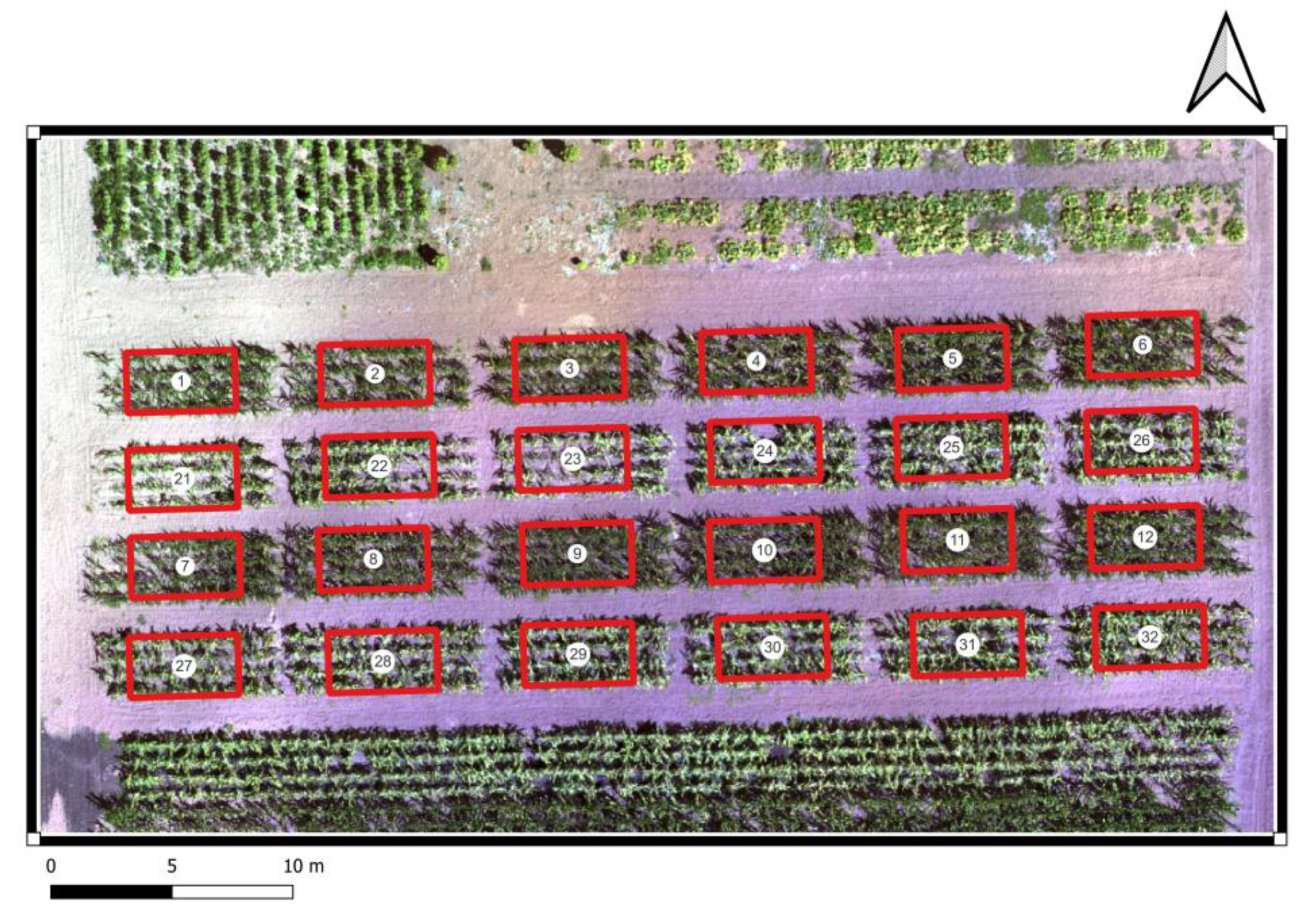
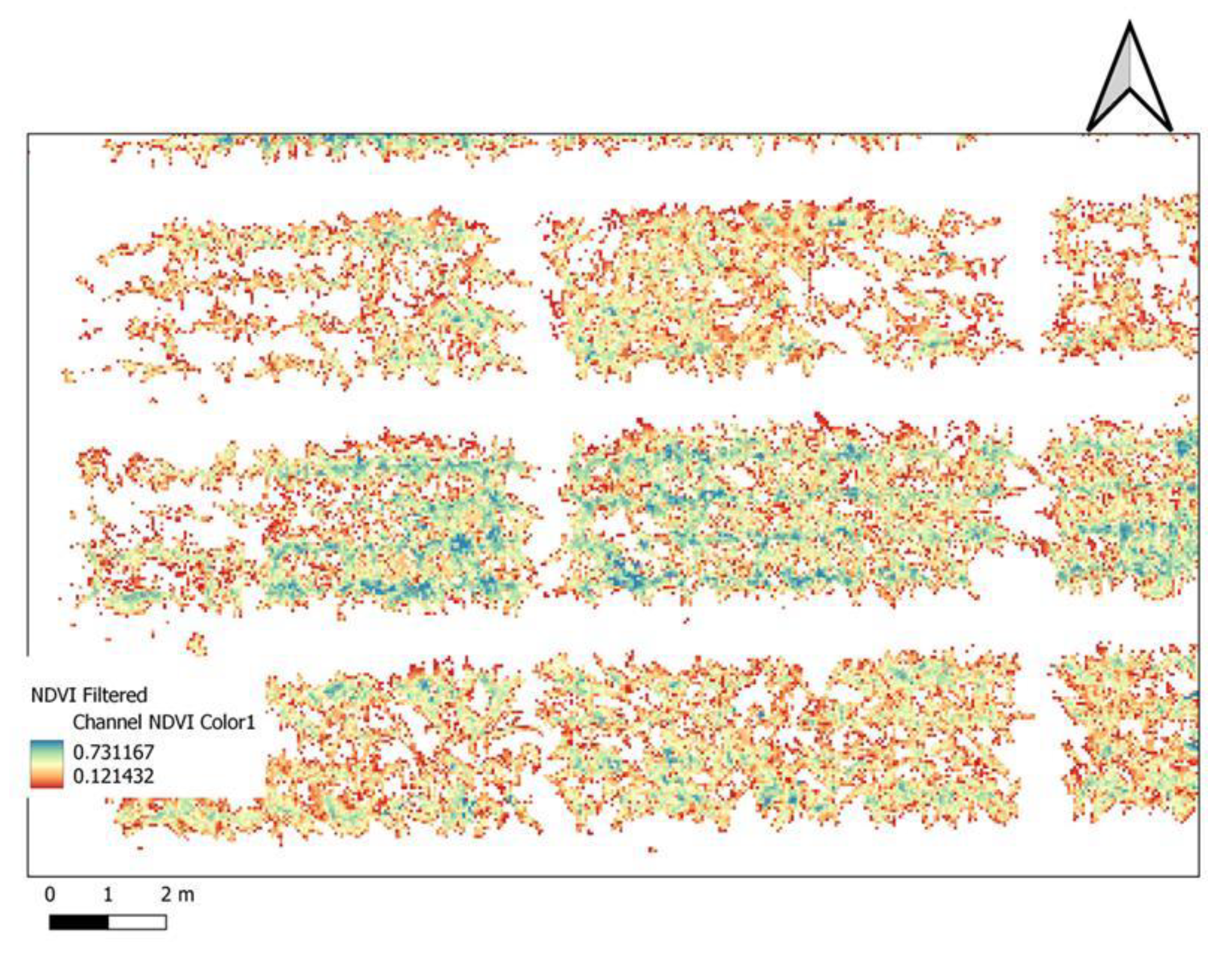
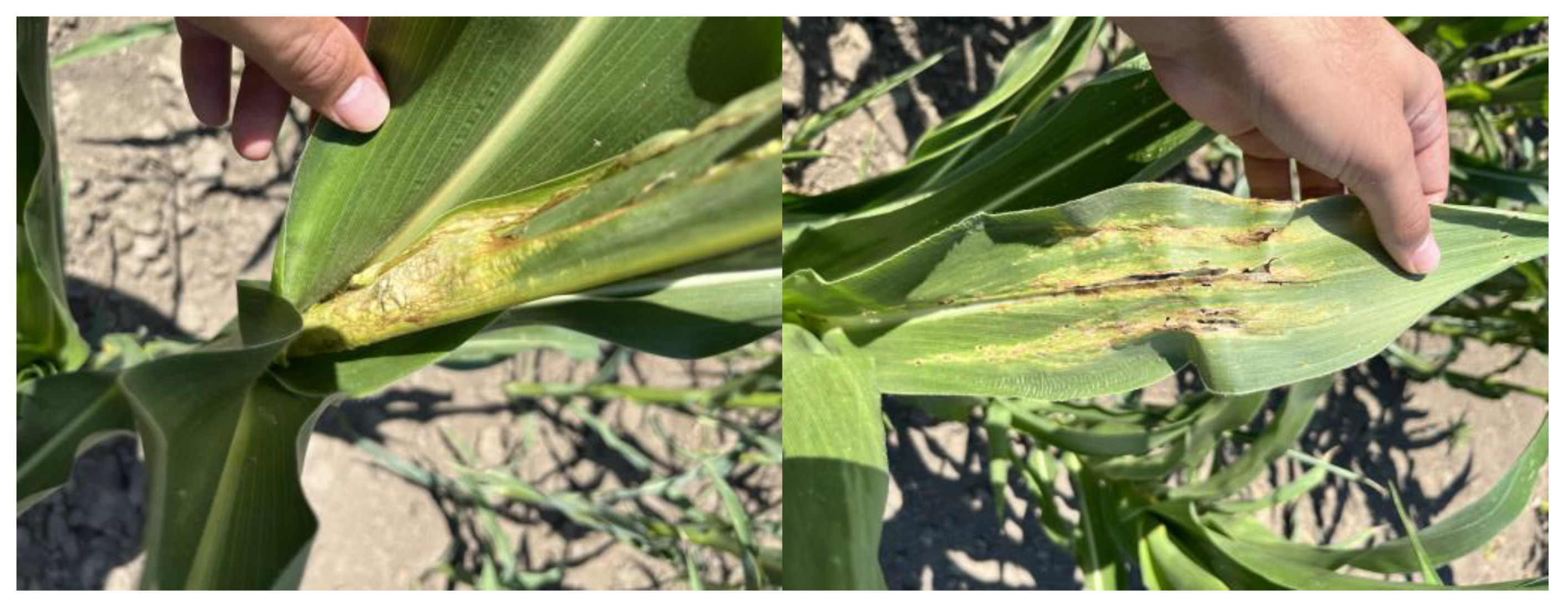
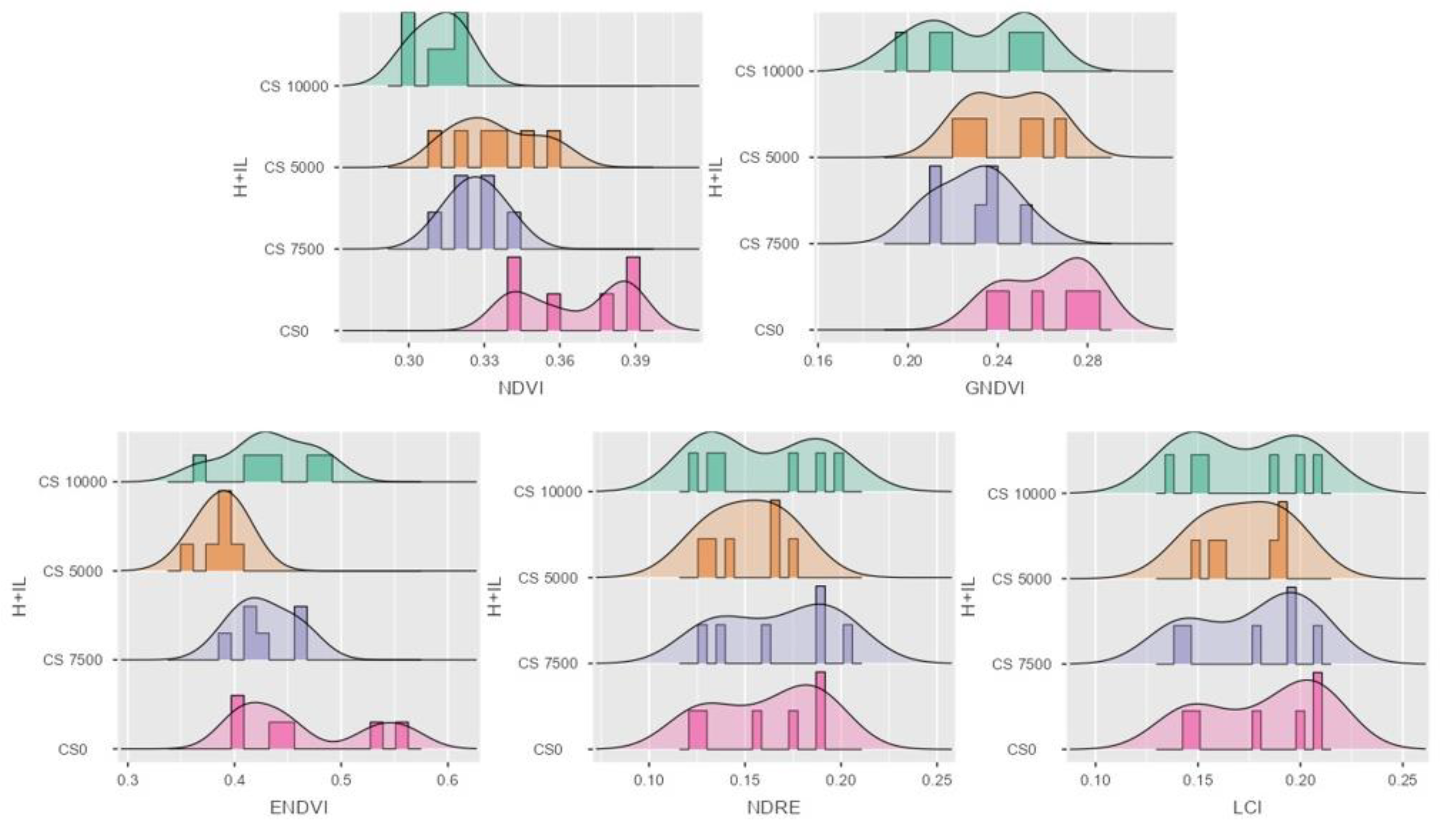
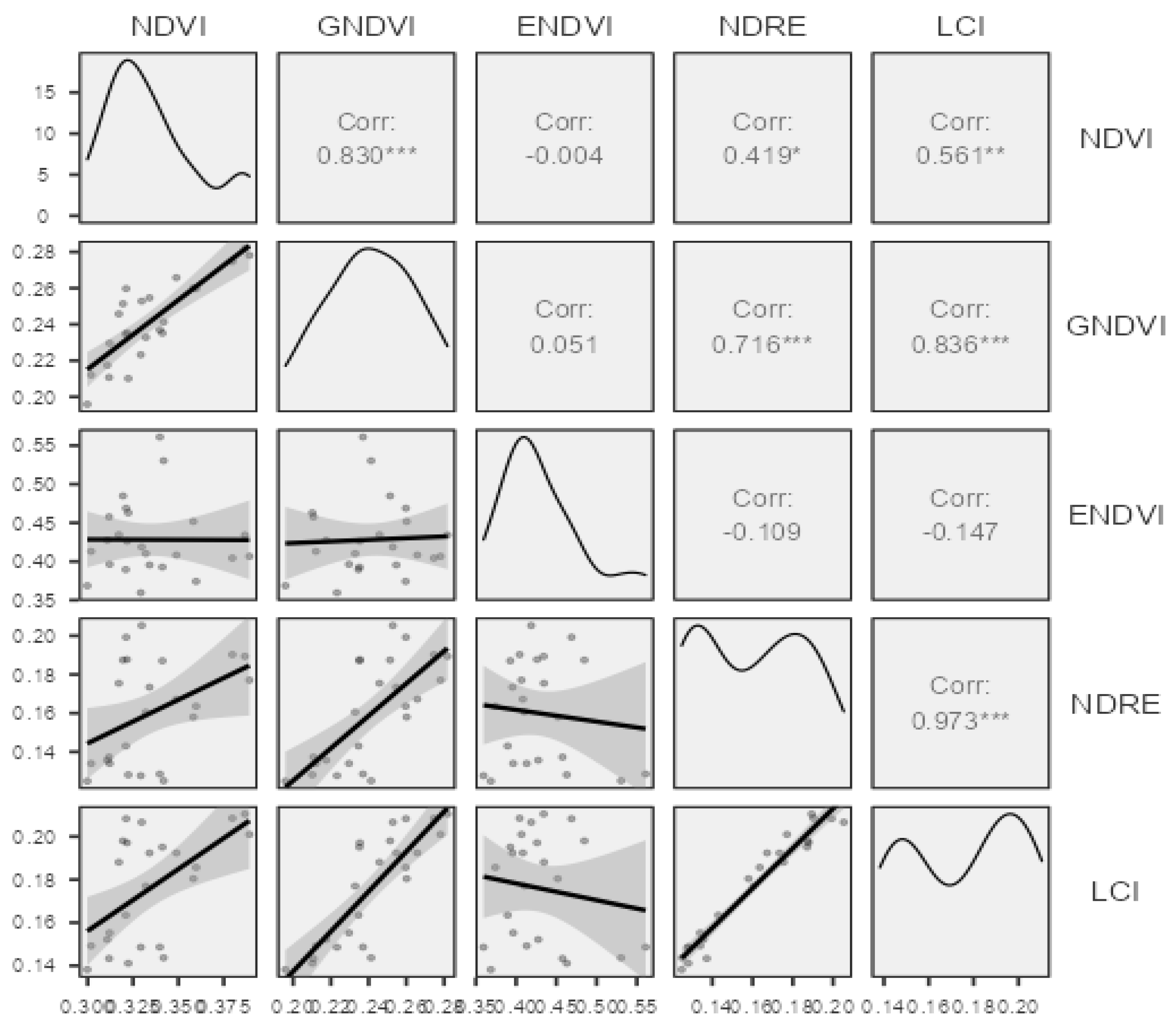
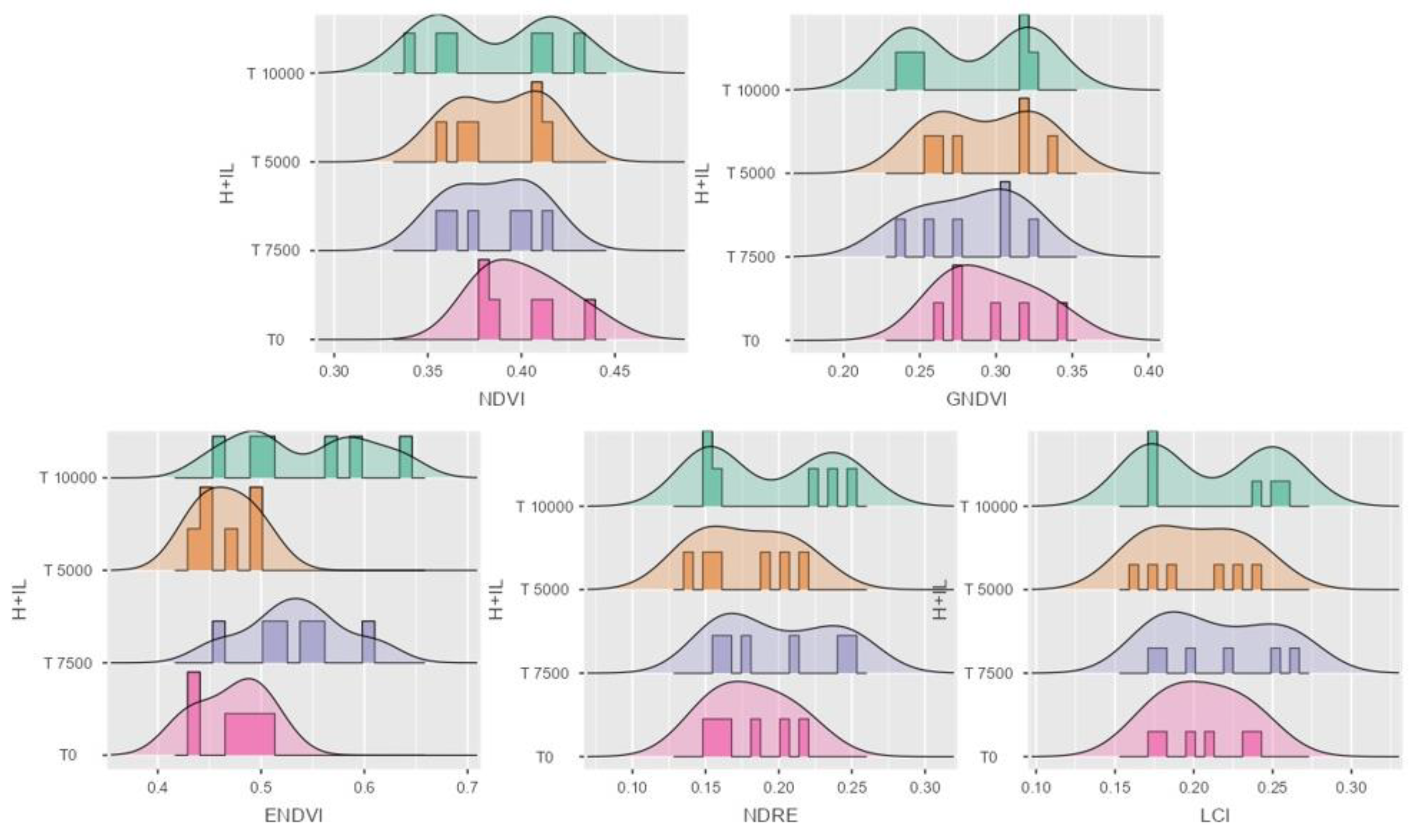


| Tukey Post-Hoc Test—NDVI Dessert R87 | |||||
|---|---|---|---|---|---|
| CS 10,000 | CS 5000 | CS 7500 | CS 0 | ||
| CS 10,000 | Mean difference | - | −0.02247 | −0.014767 | −0.05422 *** |
| p-value | - | 0.0964 | 0.39 | 4.43 × 10−5 | |
| CS 5000 | Mean difference | - | 0.0077 | −0.03175 * | |
| p-value | - | 0.832 | 0.01147 | ||
| CS 7500 | Mean difference | - | −0.03945 ** | ||
| p-value | - | 0.0017 | |||
| CS 0 | Mean difference | - | |||
| p-value | - | ||||
| Tukey Post-Hoc Test—GNDVI Dessert R78 | |||||
|---|---|---|---|---|---|
| CS 10,000 | CS 5000 | CS 7500 | CS 0 | ||
| CS 10,000 | Mean difference | - | −0.01419 | 8.95 × 10−4 | −0.03177 |
| p-value | - | 0.616 | 1 | 0.0551 | |
| CS 5000 | Mean difference | - | 0.01509 | −0.01758 | |
| p-value | - | 0.57 | 0.4434 | ||
| CS 7500 | Mean difference | - | −0.03267 * | ||
| p-value | - | 0.047 * | |||
| CS 0 | Mean difference | - | |||
| p-value | - | ||||
| Tukey Post-Hoc Test—NDVI | |||||||||
|---|---|---|---|---|---|---|---|---|---|
| T 10,000 | T 5000 | T 7500 | T 0 | CS 0 | CS 5000 | CS 7500 | CS 10,000 | ||
| T 10,000 | Mean difference | - | −0.00245 | 0.001367 | −0.01527 | 0.02002 | 0.05177 ** | 0.059467 *** | 0.07423 *** |
| p-value | - | 1 | 1 | 0.93 | 0.771 | 0.00537 ** | 9.11 × 10−4 *** | 2.47 × 10−5 *** | |
| T 5000 | Mean difference | - | 0.003817 | −0.01282 | 0.02247 | 0.05422 ** | 0.061917 *** | 0.07668 *** | |
| p-value | - | 1 | 0.972 | 0.655 | 0.00309 ** | 5.07 × 10−4 *** | 1.34 × 10−5 *** | ||
| T 7500 | Mean difference | - | −0.01663 | 0.01865 | 0.0504 ** | 0.0581 ** | 0.07287 *** | ||
| p-value | - | 0.895 | 0.827 | 0.00727 ** | 0.00126 ** | 3.47 × 10−5 *** | |||
| T 0 | Mean difference | - | 0.03528 | 0.06703 *** | 0.074733 *** | 0.0895 *** | |||
| p-value | - | 0.138 | 1.47 × 10−4 *** | 2.18 × 10−5 *** | 5.48 × 10−7 *** | ||||
| Tukey Post-Hoc Test—ENDVI | |||||||||
|---|---|---|---|---|---|---|---|---|---|
| T 10,000 | T 5000 | T 7500 | T 0 | CS 0 | CS 5000 | CS 7500 | CS 10,000 | ||
| T 10,000 | Mean difference | - | 0.07609 | 0.007511 | 0.070183 | 0.076834 | 0.15432 *** | 0.11348 ** | 0.108638 ** |
| p-value | - | 0.0917 | 1 | 0.15 | 0.086 | 1.42 × 10−5 *** | 0.00195 ** | 0.00338 ** | |
| T 5000 | Mean difference | - | −0.068583 | −0.005911 | 7.40 × 10−4 | 0.07822 | 0.03739 | 0.032544 | |
| p-value | - | 0.17 | 1 | 1 | 0.0761 | 0.83159 | 0.90928 | ||
| T 7500 | Mean difference | - | 0.062672 | 0.069322 | 0.14681 *** | 0.10597 ** | 0.101127 ** | ||
| p-value | - | 0.26 | 0.1601 | 3.59 × 10−5 *** | 0.00456 ** | 0.00777 ** | |||
| T 0 | Mean difference | - | 0.00665 | 0.08413 * | 0.0433 | 0.038455 | |||
| p-value | - | 1 | 0.0442 * | 0.70488 | 0.81105 | ||||
Disclaimer/Publisher’s Note: The statements, opinions and data contained in all publications are solely those of the individual author(s) and contributor(s) and not of MDPI and/or the editor(s). MDPI and/or the editor(s) disclaim responsibility for any injury to people or property resulting from any ideas, methods, instructions or products referred to in the content. |
© 2024 by the authors. Licensee MDPI, Basel, Switzerland. This article is an open access article distributed under the terms and conditions of the Creative Commons Attribution (CC BY) license (https://creativecommons.org/licenses/by/4.0/).
Share and Cite
Radócz, L.; Juhász, C.; Tamás, A.; Illés, Á.; Ragán, P.; Radócz, L. Multispectral UAV-Based Disease Identification Using Vegetation Indices for Maize Hybrids. Agriculture 2024, 14, 2002. https://doi.org/10.3390/agriculture14112002
Radócz L, Juhász C, Tamás A, Illés Á, Ragán P, Radócz L. Multispectral UAV-Based Disease Identification Using Vegetation Indices for Maize Hybrids. Agriculture. 2024; 14(11):2002. https://doi.org/10.3390/agriculture14112002
Chicago/Turabian StyleRadócz, László, Csaba Juhász, András Tamás, Árpád Illés, Péter Ragán, and László Radócz. 2024. "Multispectral UAV-Based Disease Identification Using Vegetation Indices for Maize Hybrids" Agriculture 14, no. 11: 2002. https://doi.org/10.3390/agriculture14112002
APA StyleRadócz, L., Juhász, C., Tamás, A., Illés, Á., Ragán, P., & Radócz, L. (2024). Multispectral UAV-Based Disease Identification Using Vegetation Indices for Maize Hybrids. Agriculture, 14(11), 2002. https://doi.org/10.3390/agriculture14112002








